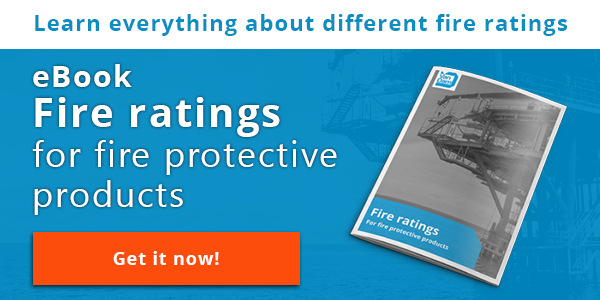
The decision of which fire rating is the right one for your fire protective door is crucial for providing fire safety for personnel and critical equipment. There are a lot of factors playing a role during this process:
Application
The door must meet your specific project requirements and needs. Environmental elements like harsh weather, the presence of salt water, hard winds, the presence of earthquake threats play a significant role. For onshore applications for example, medium duty doors with an “A0” to “A60” are sufficient enough for fire protection. For offshore application however, this is different. The further you go offshore the more difficult it gets for people to easily escape, thus get ashore. Therefore, a door must provide a lot more protection and durability. To further enhance safety, more often “H” and “J” rated doors are chosen.
Type of fire threat
Fires and flames can have a limitless number of variations regarding growth phase, peak temperature and duration. There are 3 industry recognized fire types:
- Cellulosic Fire;
- Hydrocarbon Fire;
- Jet Fire.
“A” rated doors provide protection against cellulosic fire, “H” rated doors against cellulosic and hydrocarbon fire and “J” rated doors against cellulosic, hydrocarbon and jet fire. In your decision process, you need to have insights into what kinds of fire risks your project faces.
Internal/external partition
The external parts of a structure need to have a higher fire rating than the internal partitions. The external doors are often “A”, “H” and “J” rated. Doors for internal partitions are generally “A” and “B” rated. If the fire occurs in the inner part of the structure, it is of vital importance that personnel can evacuate easily, and once they are outside the fire must be kept inside through the fire doors. As fire can also originate outside, fire resisting products must usually have the certified ability to withstand fire from both sides.
Fire integrity time
Fire integrity is the basic fire-resisting ability of a product to remain intact during a specified period, i.e., 60 minutes for 'A' Class. The higher the fire integrity time the more time there is to evacuate. For instance, an fire rated door will provide integrity against cellulosic and hydrocarbon fires for 2 hours, which gives enough time for evacuation.
All these factors can help you in deciding upon the best fire rating or fire ratings for you door(s).
Download our eBook to gain more knowledge on the different types of fire ratings and how & where they can be applied.







